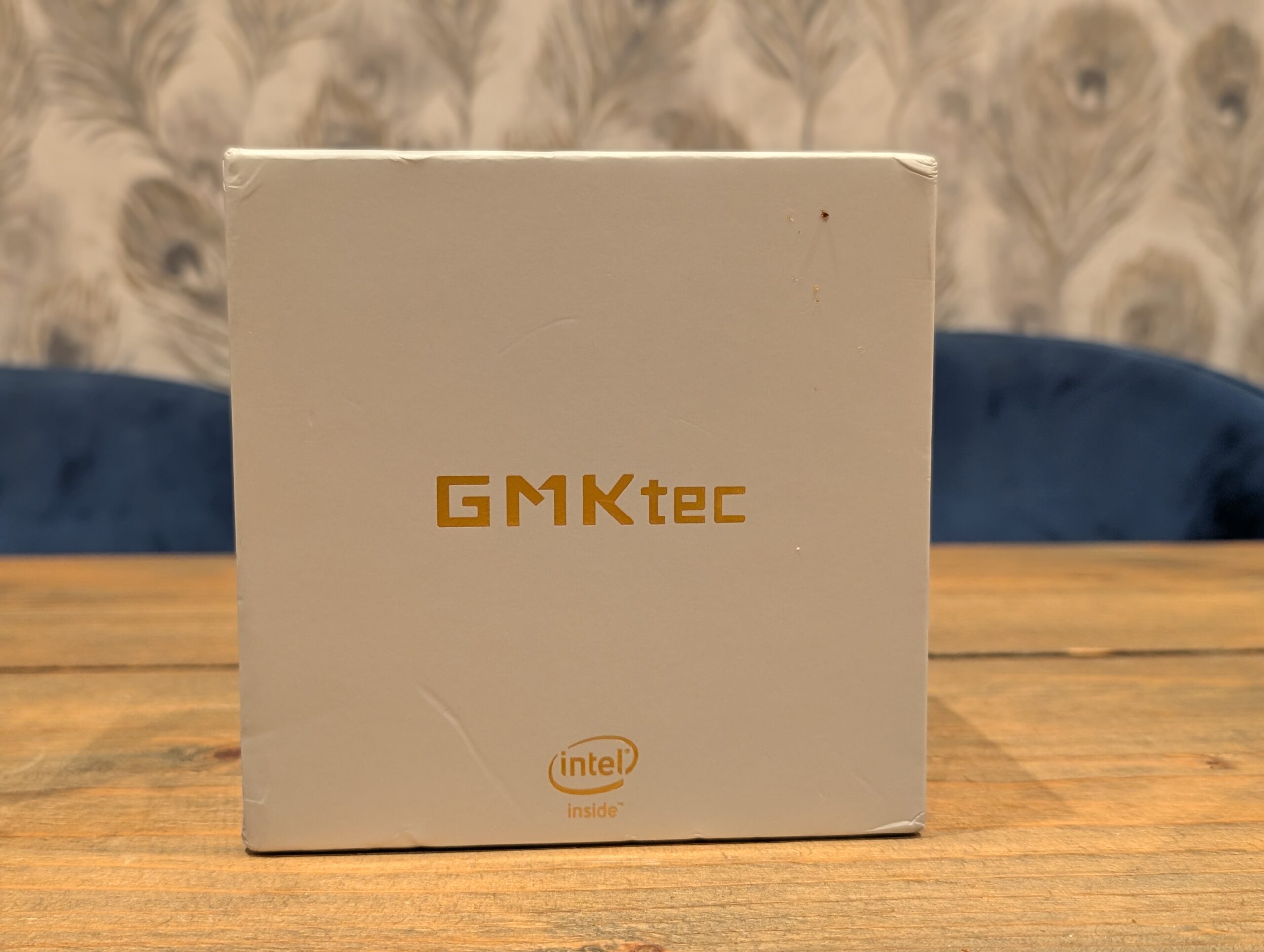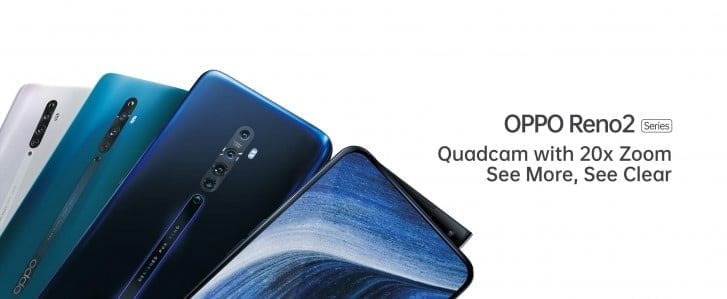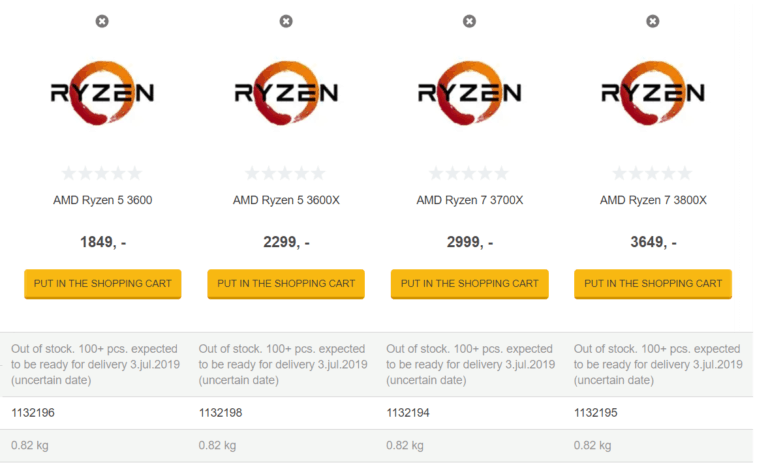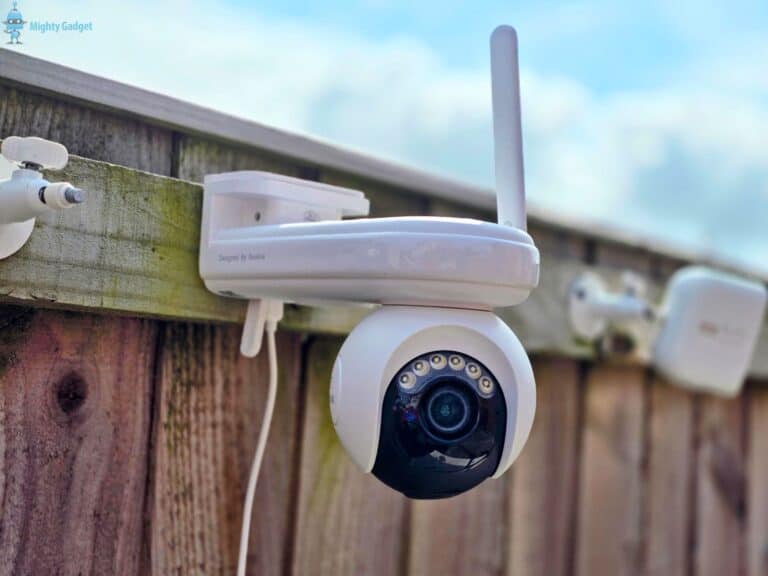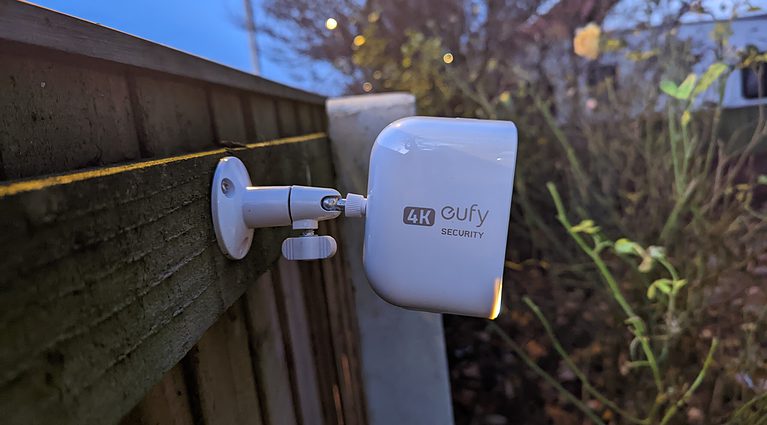Any links to online stores should be assumed to be affiliates. The company or PR agency provides all or most review samples. They have no control over my content, and I provide my honest opinion.
In the past few years, mini-PCs have become incredibly popular. They are a low-cost, ultra-small solution that provides versatile functionality. Many use them as an alternative to a full-sized desktop or laptop, but they are also incredibly popular as media PCs and home servers.
I have reviewed several options from Geekom, including the Geekom A5 Mini PC, Mini IT13 and Mini IT11. For over a year, when I was working at home, I used the Mini IT13 as my main work PC, and it worked perfectly, using far less power than my desktop PC. More recently, I have repurposed them as Proxmox servers hosting multiple applications, a Windows VM that I can remote into from my work, and a second Windows VM that allows me to access my work profile from home.
During Black Friday, I saw a deal for the GMKTec NucBox G2, which was available for just £80 and featured an Intel 12th Gen Alder Lake N100 CPU. While this CPU is very low-powered, it should still be fine as a basic desktop machine or as a cheap low-powered server, and it is arguably a better buy than the Raspberry Pi 5.
| Preview | Product | Rating | Price | |
|---|---|---|---|---|

| GMKtec G2 Plus Mini PC Windows 11 Pro Intel Twin Lake... |
£188.96 | Buy on Amazon |
Related Reviews
- Geekom A5 Mini PC Review
- Geekom Mini IT13 Mini PC Review
- Geekom Mini IT11 Mini PC Review
- Apcsilmic DOT 1 Mini PC Review
- Azulle Byte4 Fanless Mini PC Review
- Geekom Mini IT8 Mini Desktop PC Review
Specification
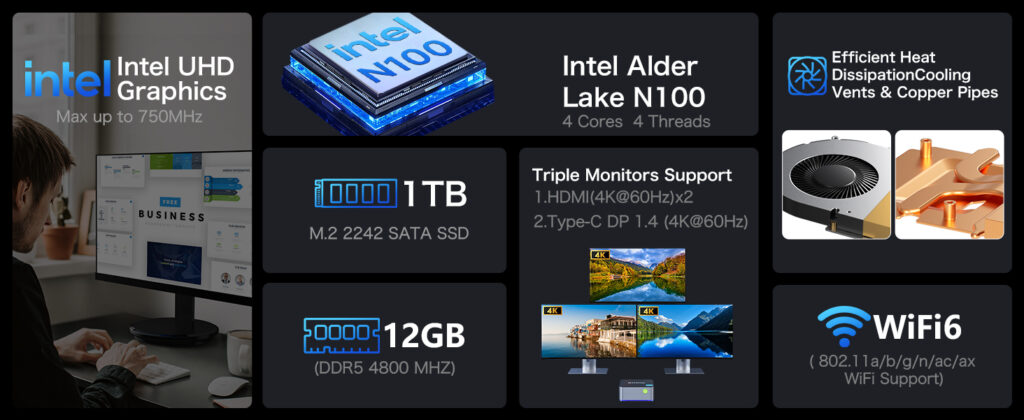
Specification | GMKtec NucBox G2 Mini PC |
Processor | Intel 12th Gen Alder Lake-N100, 4 Cores / 4 Threads |
Graphics | Intel UHD Graphics, Up to 750 MHz, 24 Execution Units |
Memory (RAM) | 12 GB LPDDR5, 4800 MT/s (Onboard) |
Storage | 1 TB M.2 2242 SATA SSD (Shipped), Expandable up to 2 TB |
Operating System | Windows 11 Pro (Pre-installed), Linux Supported |
Wireless Connectivity | Bluetooth 5.2, Wi-Fi 6 |
Video Outputs | 2 x HDMI (4K @ 60Hz) |
USB Ports | 3 x USB 3.2 Gen 1 (5 Gbps) |
Audio Jack | 1 x 3.5 mm Headphone Jack |
Ethernet | 2 x Gigabit LAN (RJ45, 1000 Mbps) |
Weight | 0.48 lb (216 g) |
Dimensions | Not specified |
Included Accessories | 2 Top Covers |
Technical Support | 12-Month Lifetime Technical Support |
Display Support | Supports up to 3 Displays simultaneously |
Unboxing / Design
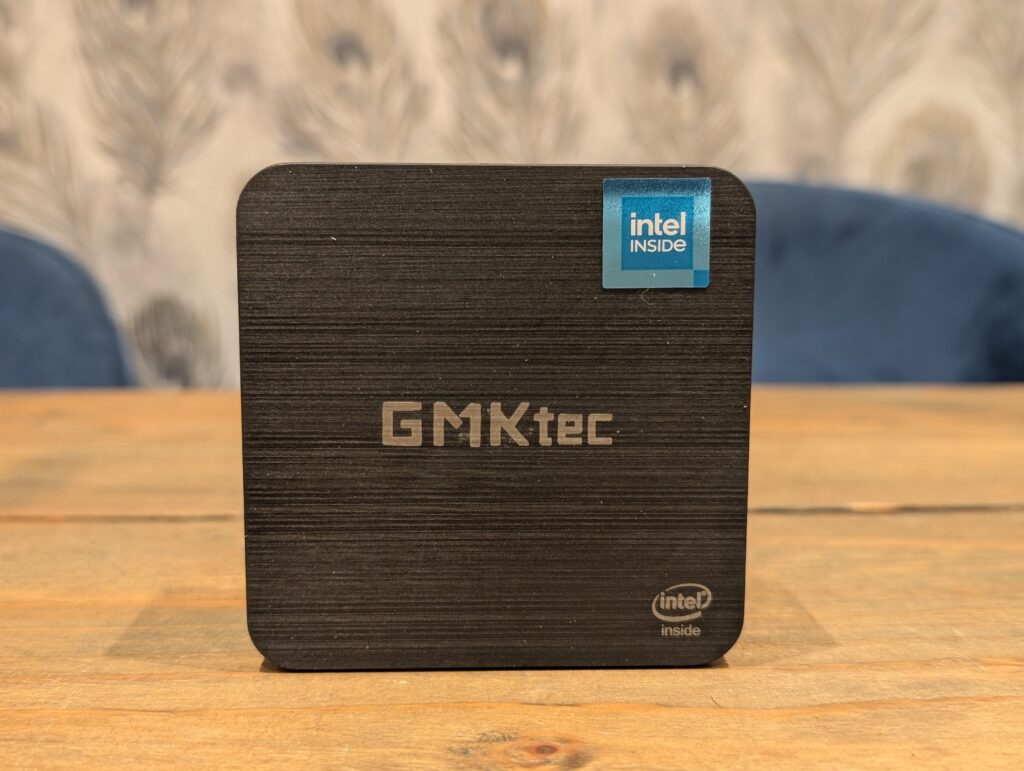
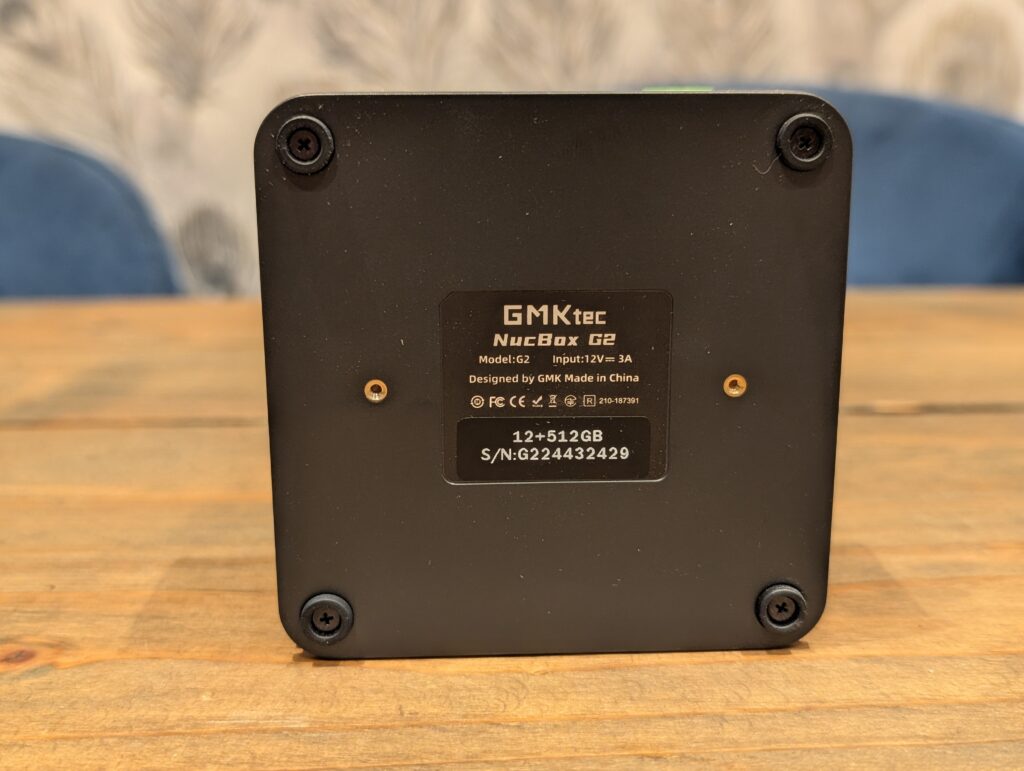
The NucBox G2 stands out with its incredibly compact dimensions, measuring just 86x86x40mm. This tiny footprint makes it an excellent choice for space-constrained environments or for those looking to minimise desk clutter. The device’s weight of just 216 grams further emphasises its portability.
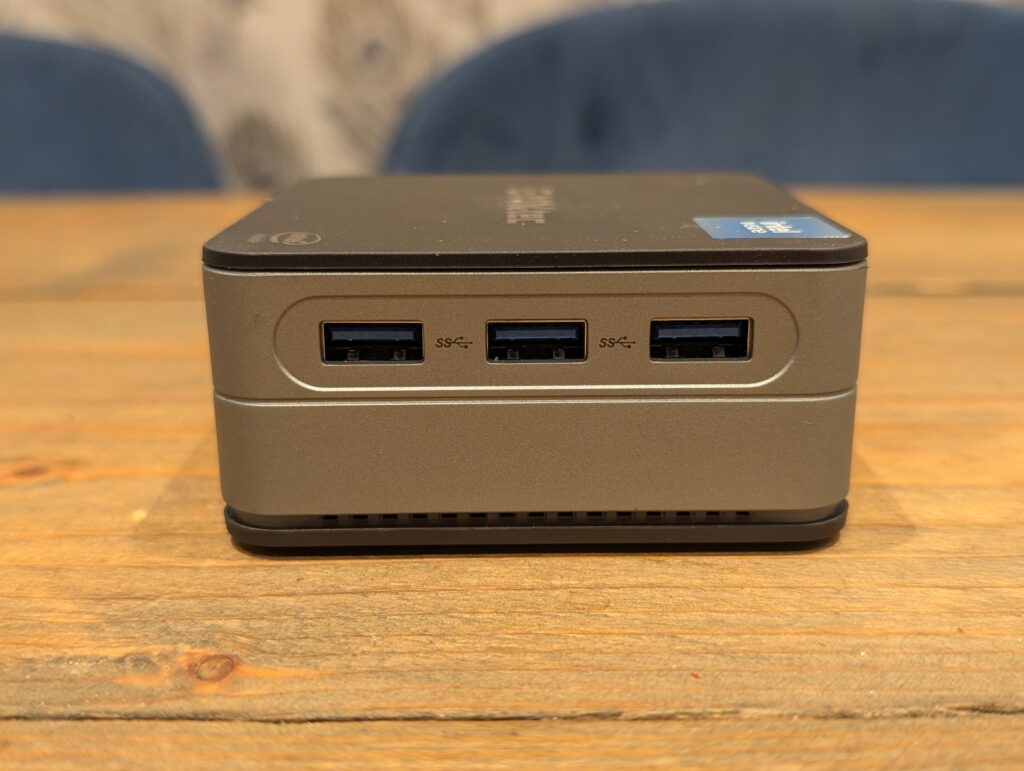
GMKTec has paid attention to aesthetics, offering the NucBox G2 with interchangeable top covers. Depending on the model, you can choose between black, red, or blue covers, allowing for some personalisation. This is a nice touch that sets it apart from many other mini PCs on the market.
The build quality feels solid despite the lightweight nature of the device. The plastic casing seems durable enough for everyday use, though it doesn’t quite match the premium feel of some higher-end mini PCs.
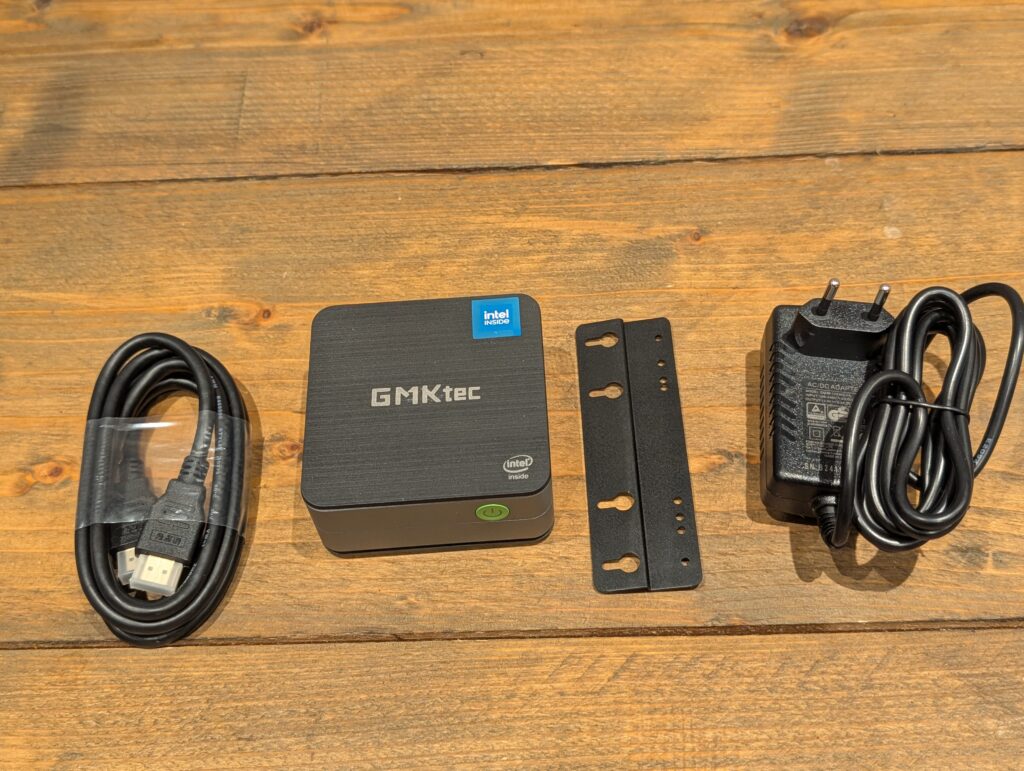
One of the standout design features is the LED ring at the bottom of the device. This adds a bit of flair to the otherwise understated design, and its colour can be configured in the BIOS. While some might appreciate this touch, others may find it unnecessary or potentially distracting in certain setups.
The power button, with its bright green colour, is a bit of an odd choice. It’s certainly easy to locate, but the intensity of the green might not be to everyone’s taste. More importantly, it can somewhat mask the blue power LED when the machine is on, which might lead to some confusion.
Ports and Connectivity
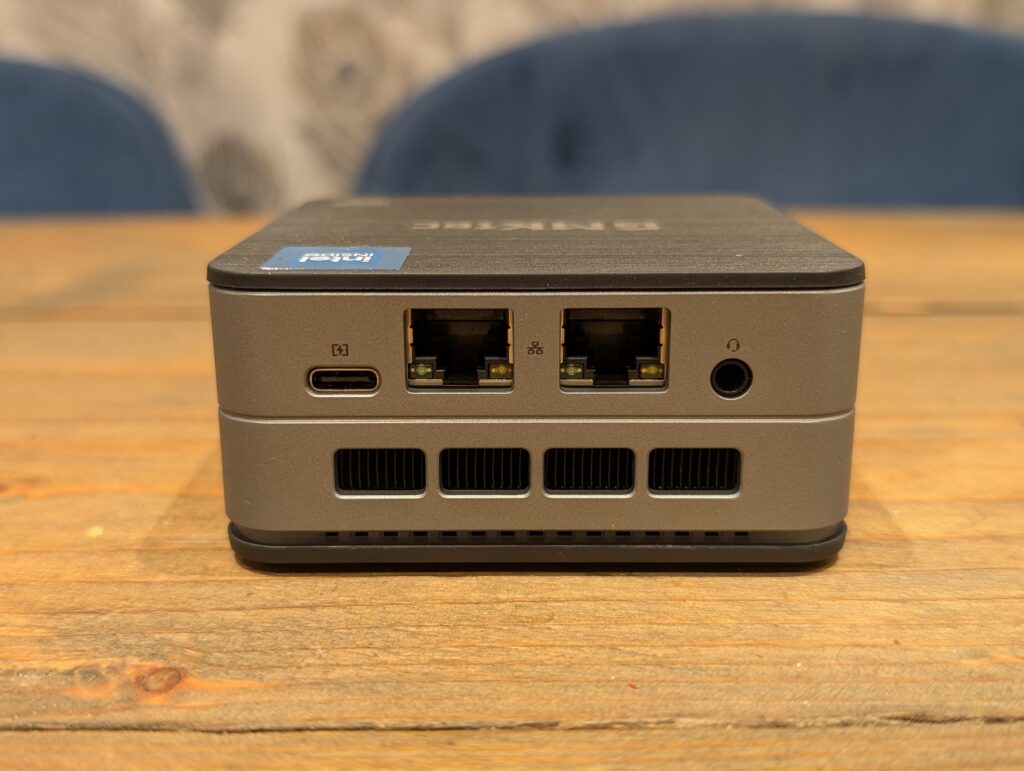
For such a small device, the NucBox G2 offers an impressive array of ports:
- 2x HDMI ports (4K @ 60Hz)
- 1x DisplayPort (DP v1.4, 4K @ 60Hz)
- 3x USB 3.2 Gen 1 ports (5 Gbps)
- 2x Gigabit Ethernet ports
- 1x 3.5mm audio jack
- 1x USB-C port for power
The inclusion of two Gigabit Ethernet ports is particularly noteworthy, as it’s not common in mini PCs of this size and price range. This feature could be especially useful for those who need to set up the device as a router, packet sniffer, or for P2P configurations.
The three USB-A ports should be sufficient for most users, providing enough connectivity for peripherals and external storage. However, the lack of a USB-C port for data or display is a missed opportunity, especially considering the growing prevalence of USB-C devices and monitors.
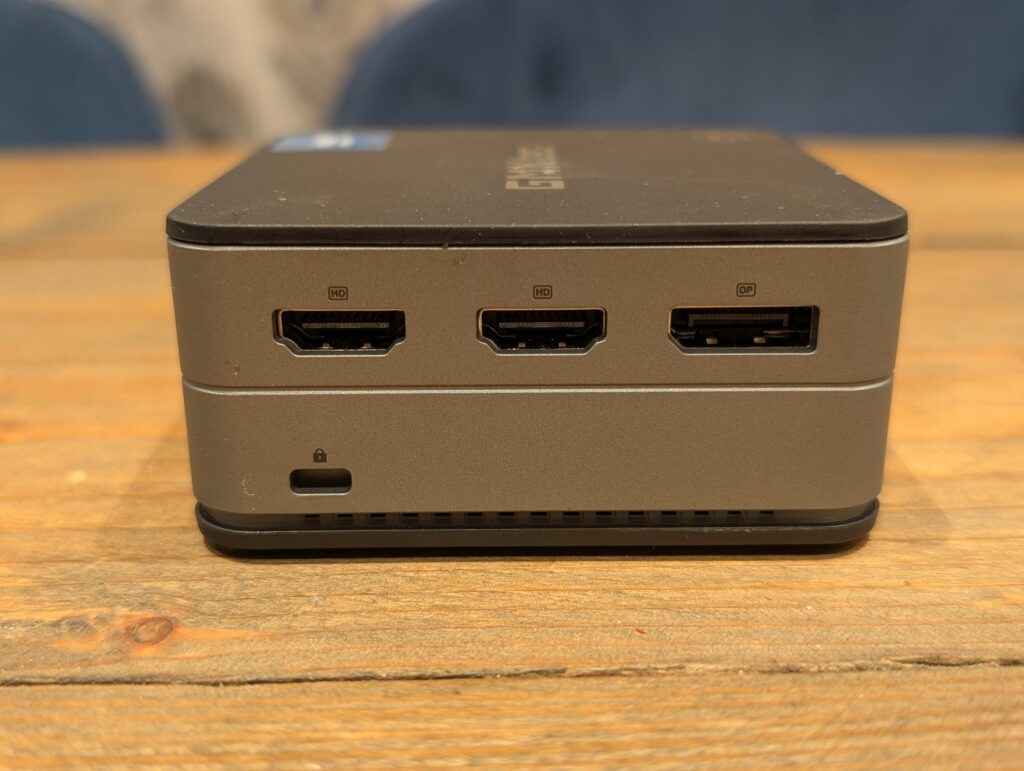
The dual HDMI ports and additional DisplayPort allow for a multi-monitor setup, which is impressive for a device of this size. This flexibility in display options could be a significant selling point for users who require multiple screens for productivity or entertainment purposes. That being said, you should be mindful of what this machine is capable of; if you are running a multi-monitor set-up, you should have realistic expectations about multi-tasking performance.
While the USB-C power delivery (12V/3A) is a welcome feature, allowing the NucBox G2 to be powered by many modern chargers, it’s disappointing that this port doesn’t support video output or data transfer. A single-cable solution for both power and display would have been a significant convenience for many users.
One notable omission is the lack of an SD card reader. While not a deal-breaker for most, it could be inconvenient for those who frequently work with cameras or other devices that use SD cards. However, this is easily remedied with an inexpensive USB adapter.
Internal Hardware and Upgradability
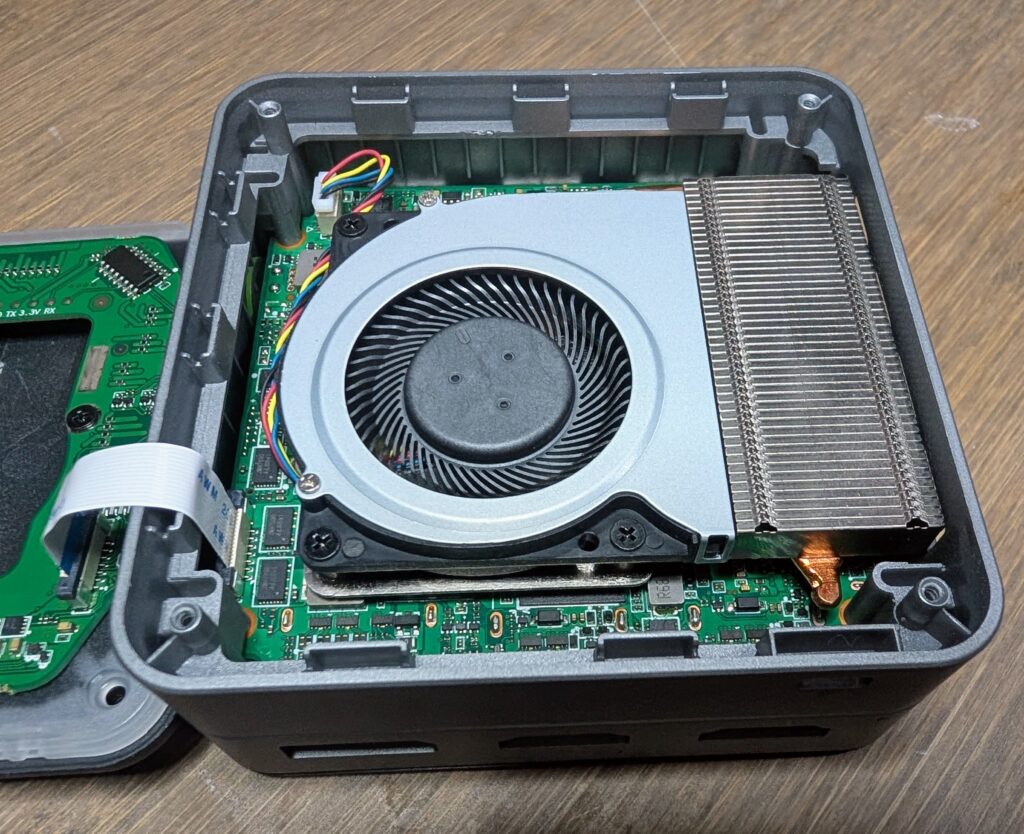
The NucBox G2 uses an Intel N100 processor, part of the 12th Gen Alder Lake family. This 4-core, 4-thread CPU offers a good balance of performance and energy efficiency, with a maximum turbo frequency of 3.4 GHz and a low 6W TDP.
The low TDP is particularly appealing to me. The rising cost of electricity and overall cost of living recently has made me eager to cut costs. I used to run desktop components as my servers before switching to mini PCs and TerraMaster NAS devices. I hope the NucBox G2 will allow me to run some essential services on this and power down my more powerful mini PCs when not in use.
The integrated Intel UHD Graphics, while not suitable for demanding gaming, provides adequate performance for everyday tasks and even light gaming at lower settings.
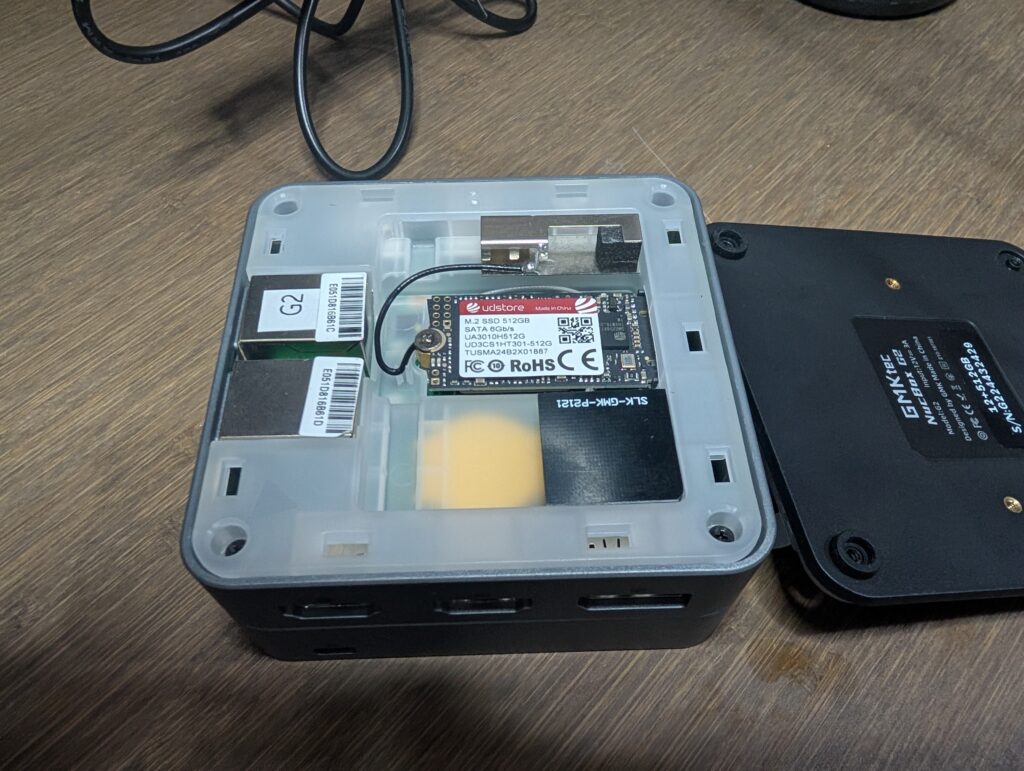
One of the standout features is the inclusion of 12GB of LPDDR5 RAM. This is a generous amount for a mini PC in this price range and should provide smooth multitasking performance for most users. The use of LPDDR5 technology ensures fast memory speeds, which can significantly impact overall system responsiveness.
Storage comes in the form of a 512TB M.2 2242 SATA SSD. While not as fast as NVMe drives, it still provides quick boot times and responsive file operations. The 512TB capacity is generous considering the £80 price tag.
In terms of upgradability, the NucBox G2 is somewhat limited. The RAM is soldered to the motherboard, so there’s no option to upgrade it later. However, the M.2 SSD can be replaced or upgraded, which is a common upgrade path for many users.
Accessing the internals is relatively straightforward. The top cover can be removed easily with a credit card or similar tool, providing access to the SSD. For more extensive access, including a view of the fan and heatsink, the rubber feet can be removed to unscrew the bottom cover.
BIOS and System Configuration
The BIOS of the NucBox G2 offers a decent range of configuration options. Users can adjust various settings, including the TDP limits of the processor. While raising the TDP can lead to minor improvements in multi-core performance, the real-world benefits may be limited unless you’re running applications that consistently max out both the CPU and GPU.
One area where BIOS tweaking can be beneficial is in fan control. The stock fan settings can lead to frequent starting and stopping of the fan, which some users might find annoying. Lowering the fan temperature threshold in the BIOS can result in more consistent, and potentially less noticeable, fan operation.
The BIOS also allows for customisation of the LED ring colour, adding a bit of personalisation to the device’s appearance.
Secure Boot is set to OFF by default, which is worth noting for those who need this feature for certain applications or security requirements. However, it can be easily enabled in the BIOS if needed.
Windows 11 Pro
The NucBox G2 comes pre-installed with Windows 11 Pro, which is a nice touch given that many mini PCs in this price range often come with Windows Home Edition. The main benefit for me would be the possibility to set this up with a Microsoft 365 Business account that’s linked to my work.
Additionally, this provides additional features like BitLocker encryption and remote desktop hosting, which could be valuable for business users or those setting up home labs.
The initial setup process is straightforward, taking about 5-10 minutes to go through the standard Windows configuration questions. Once set up, Windows activation is automatic upon connecting to the internet.
It’s worth noting that, as with many Windows machines, the first round of Windows Updates can take a considerable amount of time. Some users report needing to leave the device updating overnight. However, the system remains usable while downloading updates, which is a testament to its overall responsiveness.
For those interested in alternative operating systems, the NucBox G2 is compatible with various Linux distributions. This flexibility makes it a versatile choice for users who prefer open-source operating systems or need to run specific Linux-based applications.
I will almost certainly install Proxmox or perhaps a lightweight Linux distribution and docker to run essential but lightweight services.
Performance
While the NucBox G2 delivers impressive performance considering its size and price, I think many people would struggle to use this as a Windows machine for anything other than the lightest of work tasks.
In general use, including web browsing, document editing, and light multitasking, the NucBox G2 feels adequately responsive. The system boots quickly, and applications launch without significant delay.
Office and Productivity
The NucBox G2 does reasonably well in typical office and productivity scenarios. It handles Microsoft Office applications, web browsing with multiple tabs, and basic photo editing without too many issues. The 12GB of RAM is particularly beneficial here, allowing for smooth multitasking even with several applications open simultaneously.
There is some laggyness compared to much more powerful machines, but it is still usable.
Video Playback and Streaming
The system is more than capable of handling 4K video playback and streaming. YouTube videos at 4K resolution play smoothly, making this a viable option for a compact media centre or for users who consume a lot of high-resolution video content.
Light Content Creation
For light content creation tasks, such as basic video editing or graphic design work, the NucBox G2 performs OK. I wouldn’t really recommend it for video editing, but it has been fine for basic photo editing (depending on the application and what you are trying to do).
For more intensive creative work, the limitations of the N100 processor and integrated graphics become apparent, and users might experience some slowdowns or longer render times compared to more powerful systems.
Gaming Performance
Gaming is not the NucBox G2’s strong suit, which is expected given its integrated graphics. However, it can handle less demanding 2D games and some older 3D titles at lower settings:
- 2D games like Streets of Rage 4 run smoothly.
- 3D games generally require dropping the resolution to 720p for acceptable performance.
- Titles like Grid Autosport are playable, but more demanding games like CS:GO struggle without significant compromises in graphics settings.
Emulation Performance
One area where the NucBox G2 shines is in retro gaming emulation. It performs exceptionally well when running emulators for systems like PSP, PS2, GameCube, Wii, Wii U, and even Xbox. This makes it an excellent choice for retro gaming enthusiasts looking for a compact emulation station.
Benchmark Performance
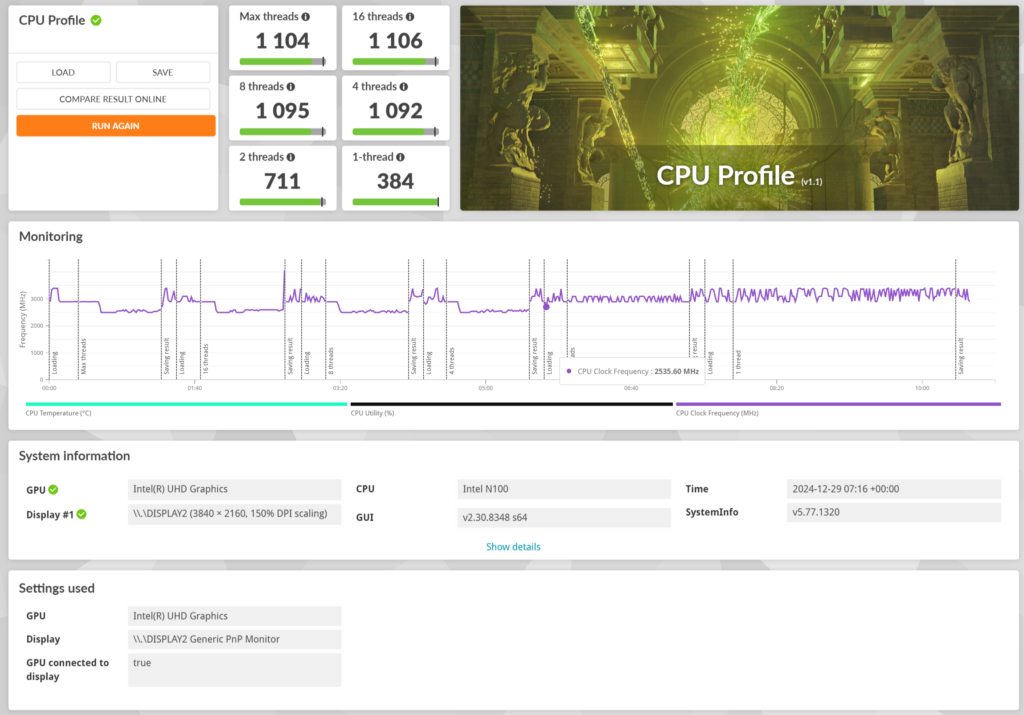
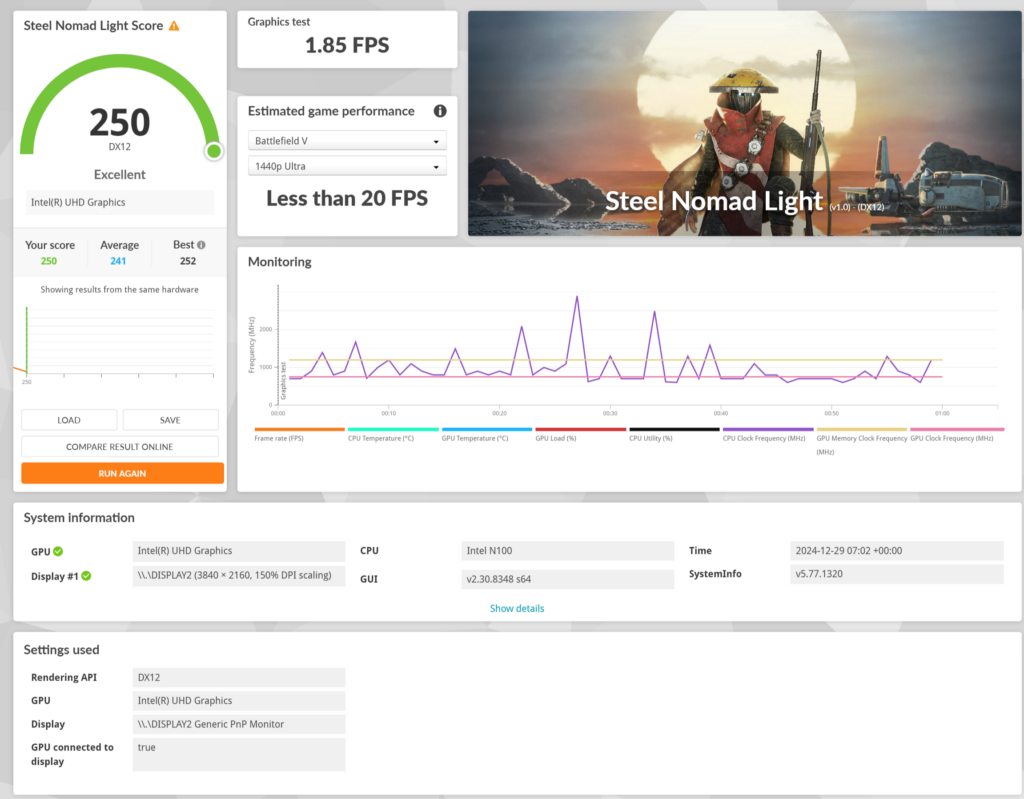
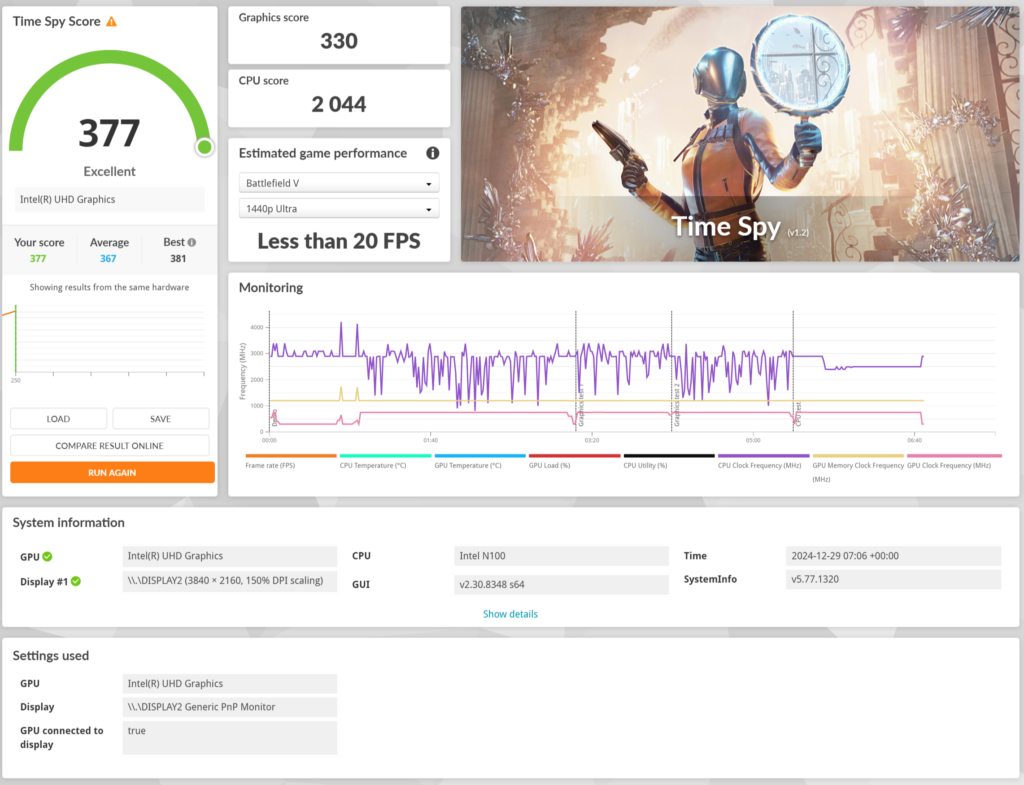
In benchmark tests, the NucBox G2 shows performance that’s generally in line with other N100-based systems, with some variations:
- Single-core performance is slightly higher than some competitors.
- Multi-core performance is about 200 points lower in some tests, possibly due to thermal constraints in the compact chassis.
The SSD, while not as fast as NVMe solutions, still provides good performance for a SATA drive, offering much snappier response times than traditional hard drives.
- Steek Nomad Light: 250
- Steel Nomad:
- TimeSpy: 377 Total, 330 Graphics, 2024 CPU
- CPU Profile (Max, 16, 8, 4, 2, 1 Threads): 1104, 1106, 1095, 1092, 711, 384
For context, the Geekom Mini IT8 achieved:
- TimeSpy: 731 Total, 642 Graphics, 3480 CPU
- CPU Profile (Max, 16, 8, 4, 2, 1 Threads): 1967, 2247, 2244, 1682, 1021, 544
Thermal Performance and Noise
The compact size of the NucBox G2 does present some challenges in terms of thermal management. Under heavy loads, temperatures can rise to around 80°C, which is warm but still within acceptable limits for this class of device.
The fan is generally quiet during light use and often turns off completely at idle. It is much quieter than all my Geekom mini PCs, which is to be expected as they are much more powerful.
Under load, the fan noise becomes more noticeable. The stock fan curve in the BIOS can lead to frequent on/off cycling, which some users might find distracting. Adjusting the fan curve in the BIOS can lead to a more consistent and potentially less noticeable fan operation.
WiFi / Networking
The inclusion of two gigabit ports is a big selling point, as you could potentially use this as a low-powered router running PFSense/OpenSense or other similar software.
The inclusion of Wi-Fi 6 is a positive; other low-priced mini PCs still use WiFi 5.
Power Consumption
The NucBox G2 is quite energy-efficient, which is expected given its use of the low-power Intel N100 processor. In idle states, the system draws around 6W of power. Under typical use scenarios, power consumption ranges from 16W to 20W, which is quite reasonable for the performance it offers.
This low power consumption makes the NucBox G2 an excellent choice for scenarios where energy efficiency is a priority, such as always-on home servers or digital signage applications.
Price and Alternative Options
| Preview | Product | Rating | Price | |
|---|---|---|---|---|

| GMKtec G2 Plus Mini PC Windows 11 Pro Intel Twin Lake... |
£188.96 | Buy on Amazon |
GMKTec lists the NucBox G2 mini-PC at £120, including 12GB DDR5 and 128GB M.2 Sata, and £160 with 512GB storage. However, on Aliexpress, this is available for just £92, including 512GB storage, and during Black Friday, I paid just £80, including delivery.
On Amazon UK, it is much more expensive, priced at £160 for the 512GB option. At the time of writing, the cheapest N100 mini PC I could find on Amazon was the TRIGKEY Key-N100, which used 16GB DDR5, WiFi 5, and a 500GB SSD, all priced at £146.
The cheapest N100 option I could find on Aliexpress was the ZXIPC Mini PC, priced at £89, but this lacked both RAM and storage. If you wanted it with 16GB DDR4 and 512GB NVME then the price is £144.
Overall
The GMKTec NucBox G2 is an excellent option in the world of affordable compact mini PCs. It is pretty much the cheapest option on the market, certainly for machines equipped with the N100.
It strikes a good balance between performance, size, and price, making it suitable for a wide range of uses, from home offices to media centres and even light server applications.
Its strengths lie in its incredibly small form factor, very low power consumption, generous RAM allocation, and versatile connectivity options. The inclusion of Windows 11 Pro and a 512TB SSD, especially at its competitive price point.
However, it’s not without its drawbacks. The N100 is very underpowered, depending on your requirements. The lack of upgradability, particularly with soldered RAM, might be a concern for some users. The fan noise under load and the absence of a USB-C port for data or display are also points to consider.
For users prioritising compact size and efficiency over raw performance, the NucBox G2 is an excellent option. It’s particularly, I’d argue to is a superior option to the Raspberry Pi 5 for most home users wanting a cheap low powered server for self-hosting applications.
GMKTec NucBox G2 Mini PC Review
Summary
The GMKTec NucBox G2 Mini PC delivers excellent value for those seeking a space-saving desktop replacement or secondary computing device. Its combination of modern hardware, versatile connectivity, and affordable pricing makes it a practical choice for home and office environments. While it has limitations regarding upgradability and heavy-duty performance, it excels in portability and energy efficiency, making it a superb option in the mini PC market (just have realistic expectations about its performance)
Overall
95%-
Overall - 95%95%
Pros
- Outstanding value for money
- Extremely compact size
- Good performance for everyday tasks
- Generous 12GB of RAM
- Multiple display outputs
- Dual Gigabit Ethernet ports
- USB-C power delivery
- Windows 11 Pro pre-installed
Cons
- N100 will struggle in anything other than the lightest of workloads
- Limited upgradability (soldered RAM)
- Fan noise can be noticeable under load
- SATA SSD instead of faster NVMe
- No USB-C port for data or display
I am James, a UK-based tech enthusiast and the Editor and Owner of Mighty Gadget, which I’ve proudly run since 2007. Passionate about all things technology, my expertise spans from computers and networking to mobile, wearables, and smart home devices.
As a fitness fanatic who loves running and cycling, I also have a keen interest in fitness-related technology, and I take every opportunity to cover this niche on my blog. My diverse interests allow me to bring a unique perspective to tech blogging, merging lifestyle, fitness, and the latest tech trends.
In my academic pursuits, I earned a BSc in Information Systems Design from UCLAN, before advancing my learning with a Master’s Degree in Computing. This advanced study also included Cisco CCNA accreditation, further demonstrating my commitment to understanding and staying ahead of the technology curve.
I’m proud to share that Vuelio has consistently ranked Mighty Gadget as one of the top technology blogs in the UK. With my dedication to technology and drive to share my insights, I aim to continue providing my readers with engaging and informative content.
Last update on 2025-07-18 / Affiliate links / Images from Amazon Product Advertising API

